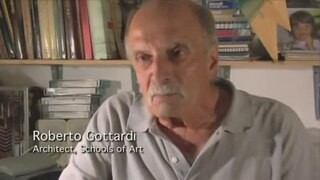Contents
This article includes a list of references, related reading, or external links, but its sources remain unclear because it lacks inline citations .(July 2014) |
This is a list of notable Cuban architects.
This article includes a list of references, related reading, or external links, but its sources remain unclear because it lacks inline citations .(July 2014) |
This is a list of notable Cuban architects.

El Tropicana Night Club in Havana, Cuba located in a lush, six-acre estate tropical garden opened on December 30, 1939 at the Villa Mina in Marianao. It is located next door to the old Colegio de Belén, Havana, presently, the Instituto Técnico Militar.

La Mansión de Mark Pollack, is a neo-classical, Florentine mansion in the Cubanacan Section of Havana, Cuba built in 1930 by the Cuban architect, Leonardo Morales y Pedroso (1887–1965). It is located at 21st street #15001, Cubanacan, Havana, Cuba. It was built for Mark Alexander Pollack (1874–1946), the son of Alexander Pollack and Belle A. Rothschild (1848-1936), the American-born patriarch of a wealthy Cuban tobacco exporter. The house covers an area of 13,000 square meters.
Max Borges Jr., born Max Borges Recio, was a Cuban architect best known for his work in Havana in the 1940s and 1950s. He later moved to the United States.

Modelo Brewery, designed by the Cuban architect Enrique Luis Varela, was built in 1948 for Compañia Ron Bacardi S.A. Its address is the corner of 52 and Carretera Central, Cotorro, Havana, Cuba. In 1952, Ernest Hemingway featured Hatuey beer in his book The Old Man and the Sea. When he was awarded the Nobel Prize for Literature, the company threw him a party at the Modelo Brewery. Hemingway was a frequent patron of the brewery since it was located near to his home in Havana at Finca Vigía.
Joaquín Blez Marcé was a Cuban photographer.
Mario Carreño y Morales was a Cuban painter.

Iglesia de Jesús de Miramar is the second largest church in Cuba. It is located in the Roman Catholic Archdiocese of San Cristobal de la Habana.
Cundo Bermúdez, born Secundino (Cundo) Bermúdez y Delgado, was a Cuban painter. Born in Havana, Cuba, he died of a heart attack in his Westchester home on October 30, 2008.
Maximiliano de la Luz Borges y del Junco was a well-known Cuban architect and Minister of Public Works during the presidency of Dr. Federico Laredo Brú of Cuba.
Hugo Consuegra was a Cuban-born artist and architect who, in 1953, became one of the founding members of Los Once, a group of young abstract expressionist artists which included the core members Guido Llinás, Raul Martinez, Tomás Oliva and Antonio Vidal. The group broke away from the representational style prevalent at the time in Cuba and produced its largest volume of work between 1953 and 1955. Consuegra and four of the original 11 continued to exhibit in what became known as the post-revolutionary avant-garde movement in Cuba. Consuegra was also a Professor of Art History at Havana University’s School of Architecture (1960–5).

Leonardo Morales y Pedroso was one of the most prominent Cuban architect in Cuba in the first half 20th century. In 1900 he entered and attended pre-university studies at De Witt Clinton High of New York, where he obtained a bachelor's degree. In 1909 he graduated of Bachelor in Architecture from Columbia University. After graduating, he returned to Cuba in 1909 where he worked a time in the local architect firm of Newton & Sola with the architect Thomas M. Newton, who was director of the civil construction section of the Secretary of Public Works during the 2nd American intervention in Cuba. In February 1910, he returned to the United States and obtained a master's degree (Doctor) in Architecture from Columbia University in the State of New York. After obtaining his doctorate in architecture he joined in March 1910 the architecture Company Morales y Mata arquitectos, created in 1907 by his elder brother the engineer Luis Morales y Pedroso in association with the master builder Jose F. Mata. In 1917, after having built more than 30 important buildings, they decided to separate from José Mata, who had to stop working because illness and died a short time later. The company changed its name for Morales y Compañia Arquitectos with his brother the engineer Luis Morales y Pedroso as president and Leonardo as Associate together with other 7 architects. He was able to obtain noteworthy real estate commissions partly because of his family's origin, good social connections and social standing in Havana high society. He was named by the Cuban press of the time as the "Havana's architect" and his architectural style is recognized as the "Morales style". During 50 years Leonardo Morales y Pedroso received around 250 notable architectural commissions, some of them include:
Mark Alexander Pollack was one of the largest exporters of Cuban tobacco, a painter, and the owner of "La Mansion".

Ricardo Porro Hidalgo was a Cuban-born architect. He graduated in architecture from the Universidad de la Habana in 1949 and built this year his first project Villa Armenteros in Havana, following which he spent two years in post-graduate studies at the Institute of Urbanism at the Sorbonne.

Roberto Gottardi was an Italian-Cuban architect.

Vittorio Garatti was an Italian architect.

Colegio Nacional de Arquitectos de Cuba (C.N.A.C.) is a Cuban national institution based in Havana, that grew out of El Colegio de Arquitectos de La Habana.

The Colegio de Belén located between 45th and 66th streets, situated next door to the Tropicana nightclub, in Marianao, Havana, was designed in 1925 by the architect Leonardo Morales y Pedroso and his brother the engineer Luis Morales y Pedroso of the firm Morales y Compañía Arquitectos.